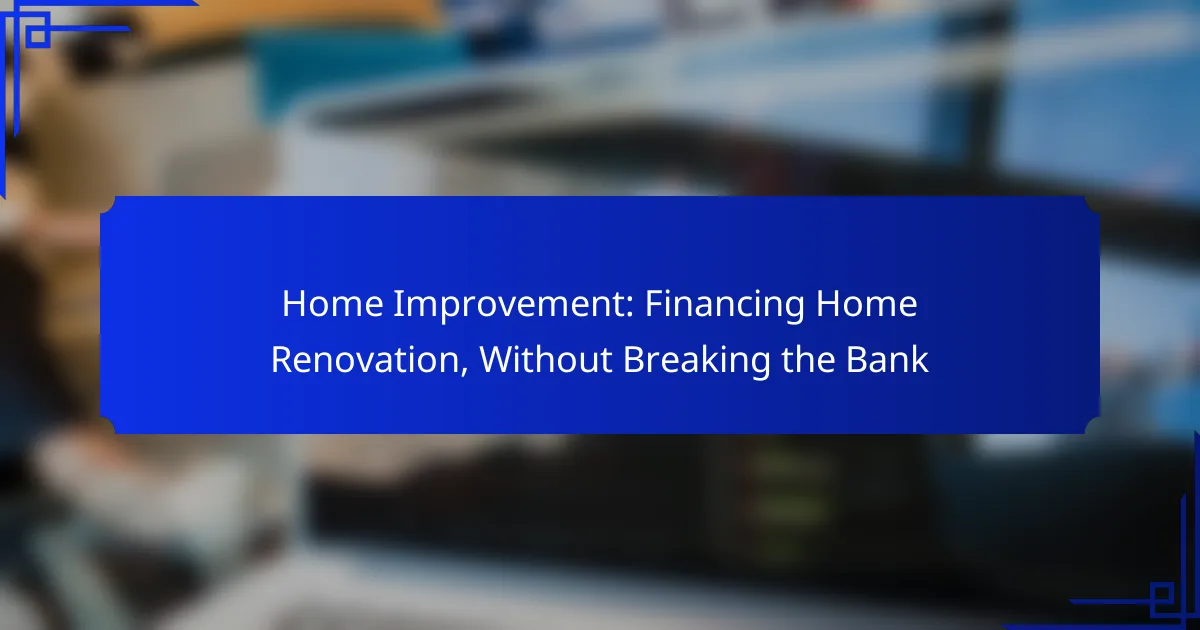Financing home renovations can be a manageable endeavor with the right approach, allowing homeowners to enhance their living spaces without exceeding their budgets. By exploring various funding options such as loans, grants, and credit, individuals can find solutions tailored to their financial situations. Effective budgeting and careful selection of financing methods are key to achieving renovation goals while maintaining financial stability.

How can I finance home renovations in the United States?
In the United States, financing home renovations can be achieved through various options, each with its own benefits and considerations. Homeowners can explore loans, grants, and credit options to fund their projects without straining their budgets.
Home equity loans
Home equity loans allow homeowners to borrow against the equity they have built in their property. Typically, these loans offer fixed interest rates and are paid back over a set term, often ranging from 5 to 30 years.
When considering a home equity loan, evaluate your current equity, which is the difference between your home’s market value and your mortgage balance. Be cautious of the potential risks, as failing to repay could lead to foreclosure.
Personal loans
Personal loans are unsecured loans that can be used for various purposes, including home renovations. These loans usually have higher interest rates compared to secured loans, but they do not require collateral.
When applying for a personal loan, check your credit score, as it significantly impacts the interest rates offered. Loan amounts can vary widely, typically from a few thousand to tens of thousands of dollars, depending on the lender and your creditworthiness.
Government grants
Government grants for home renovations are available through various federal and state programs aimed at improving housing conditions. These grants do not require repayment, making them an attractive option for eligible homeowners.
To qualify for a grant, you may need to meet specific income requirements or demonstrate a need for home improvements. Research local programs, as availability and eligibility criteria can vary significantly by location.
Credit cards
Using credit cards for home renovations can be a quick way to finance smaller projects. Many credit cards offer promotional interest rates, such as 0% APR for an introductory period, which can save money if paid off promptly.
However, be cautious of high-interest rates once the promotional period ends. It’s advisable to keep your credit utilization low and ensure that you can manage monthly payments to avoid accumulating debt.
FHA 203(k) loans
The FHA 203(k) loan is a government-backed mortgage designed for homebuyers looking to purchase and renovate a property simultaneously. This loan combines the purchase price and renovation costs into a single mortgage, making it easier to finance extensive renovations.
To qualify, the property must meet specific criteria, and the renovations must be completed within a set timeframe. This option is particularly beneficial for first-time homebuyers or those looking to buy fixer-uppers, as it allows for a lower down payment compared to conventional loans.

What are the best budgeting strategies for home improvement?
Effective budgeting strategies for home improvement involve setting a clear budget, prioritizing renovations, and utilizing cost estimation tools. These approaches help homeowners manage expenses while achieving their renovation goals without overspending.
Set a clear budget
Establishing a clear budget is the foundation of any successful home improvement project. Start by determining how much you can afford to spend, considering both your savings and potential financing options. A well-defined budget will guide your decisions and help prevent overspending.
When setting your budget, include all potential costs such as materials, labor, permits, and unexpected expenses. A common recommendation is to allocate an additional 10-20% of your budget for unforeseen costs, ensuring you are prepared for any surprises that may arise during the renovation process.
Prioritize renovations
Prioritizing renovations is crucial to ensure that your budget is spent effectively. Identify which projects will add the most value to your home or improve your quality of life. For instance, kitchen and bathroom remodels often yield higher returns on investment compared to other renovations.
Create a list of desired renovations and rank them based on importance and budget constraints. Focus on completing high-priority projects first, which can help you stay within budget while still enhancing your home’s overall appeal.
Use cost estimation tools
Cost estimation tools can significantly aid in budgeting for home improvements. These tools allow you to input project details and receive estimates for materials and labor costs, helping you make informed decisions. Many online calculators are available that can provide quick estimates based on your specifications.
Additionally, consider consulting with contractors for detailed quotes. Getting multiple estimates can help you compare prices and identify the best value for your renovation needs. Always ensure that estimates include a breakdown of costs to avoid unexpected charges later on.

How can I choose the right financing option?
Choosing the right financing option for home renovation involves assessing your financial situation, understanding loan terms, and comparing interest rates. This process ensures you select a solution that fits your budget and renovation goals without causing financial strain.
Assess your credit score
Your credit score significantly impacts the financing options available to you. Generally, a score above 700 is considered good and may qualify you for lower interest rates and better loan terms.
Before applying for financing, check your credit report for errors and consider paying down existing debts to improve your score. This preparation can enhance your chances of securing favorable financing.
Evaluate loan terms
Loan terms include the duration of the loan, repayment schedule, and any fees associated with borrowing. Shorter loan terms typically have higher monthly payments but lower overall interest costs, while longer terms may offer lower payments but accumulate more interest over time.
Compare different loan products to understand the implications of each term. For example, a 15-year mortgage might save you thousands in interest compared to a 30-year option, but it requires a larger monthly payment.
Consider interest rates
Interest rates directly affect the total cost of your renovation financing. Fixed rates provide stability, while variable rates can fluctuate based on market conditions, potentially leading to lower initial payments but higher costs over time.
Shop around for the best rates from various lenders, including banks, credit unions, and online lenders. Even a small difference in interest rates can lead to significant savings over the life of the loan, so it’s worth investing time in this comparison.

What are the benefits of using a home equity line of credit?
A home equity line of credit (HELOC) offers several advantages for financing home renovations, including flexibility, lower borrowing costs, and potential tax benefits. By leveraging the equity in your home, you can access funds as needed for various projects without incurring high-interest debt.
Flexible borrowing
One of the main benefits of a HELOC is its flexible borrowing structure. Homeowners can withdraw funds as needed, up to a predetermined limit, making it ideal for ongoing renovation projects. This allows you to only borrow what you need, reducing unnecessary interest payments.
Additionally, many HELOCs offer a draw period, typically lasting 5 to 10 years, during which you can access funds without having to repay the principal. This flexibility can be particularly useful for managing cash flow during extensive renovations.
Lower interest rates
HELOCs generally offer lower interest rates compared to credit cards and personal loans, making them a cost-effective option for financing home improvements. Rates can vary, but they are often tied to the prime rate, which means they may be lower than other forms of credit.
It’s important to shop around and compare offers from different lenders to find the best rate. Keep in mind that variable interest rates can fluctuate, so consider your ability to manage potential increases in monthly payments.
Tax-deductible interest
Another benefit of using a HELOC is that the interest paid on the loan may be tax-deductible, provided the funds are used for home improvements. This can lead to significant savings, especially for larger renovation projects.
To qualify for the deduction, ensure that you meet IRS guidelines and consult with a tax professional to understand how the deduction applies to your specific situation. Keep thorough records of your expenses to maximize your potential tax benefits.

What are common mistakes to avoid when financing renovations?
Common mistakes when financing renovations include underestimating costs, ignoring long-term impacts, and not comparing financing options. Being aware of these pitfalls can help you manage your budget effectively and ensure a successful renovation project.
Underestimating costs
One of the most frequent errors is underestimating the total costs of renovations. Homeowners often overlook expenses such as permits, materials, labor, and unexpected repairs, which can add up quickly. A good rule of thumb is to budget an additional 10-20% beyond your initial estimate to cover these unforeseen expenses.
To avoid this mistake, create a detailed budget that includes all potential costs. Consider consulting with contractors to get accurate quotes and factor in contingencies for any surprises that may arise during the renovation process.
Ignoring long-term impacts
Another mistake is failing to consider the long-term impacts of financing choices. Short-term savings might seem appealing, but they can lead to higher overall costs due to interest rates or unfavorable terms. For example, a lower monthly payment might come with a longer loan term, resulting in more interest paid over time.
Evaluate financing options not just for immediate affordability but also for their long-term implications. Look for loans with favorable interest rates and terms that align with your financial goals, ensuring that your renovation investment pays off in the long run.
Not comparing options
Many homeowners do not take the time to compare different financing options, which can lead to missed opportunities for savings. Interest rates, loan terms, and fees can vary significantly between lenders, impacting your overall renovation budget. Failing to shop around might result in paying more than necessary.
To make informed decisions, gather quotes from multiple lenders and compare their offerings. Use online calculators to assess the total cost of each option over time, and consider seeking advice from financial advisors to ensure you choose the best financing solution for your renovation needs.
